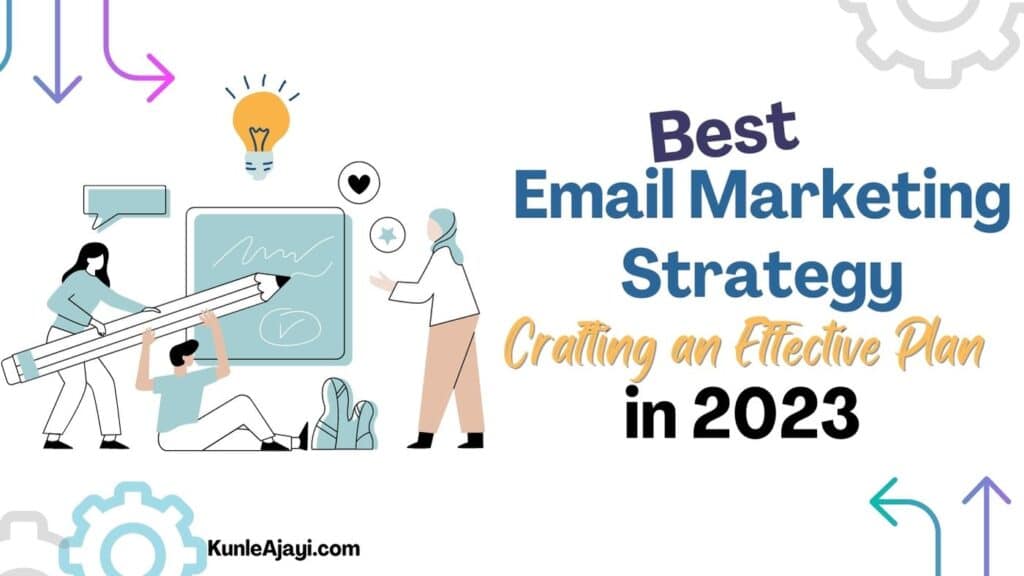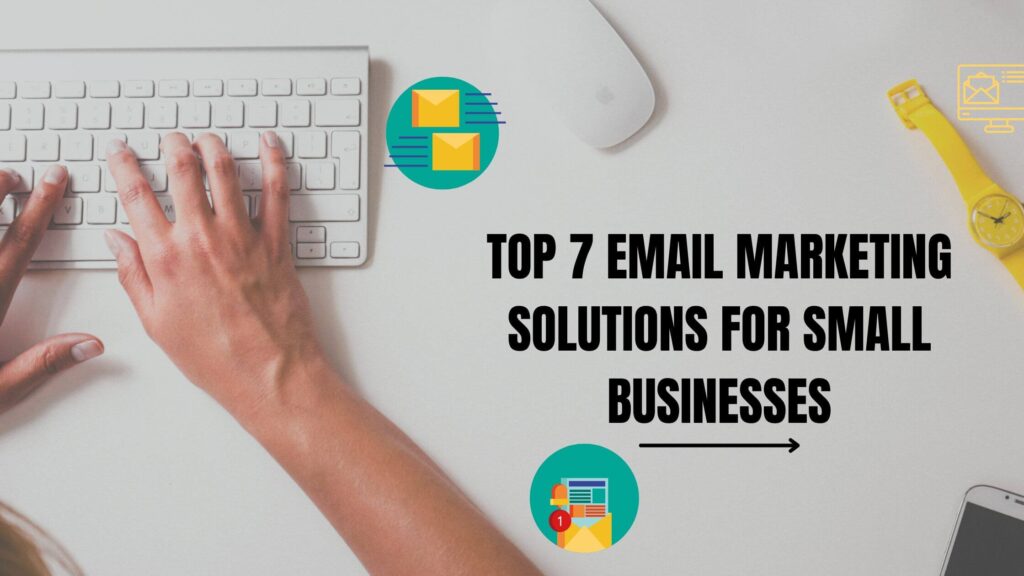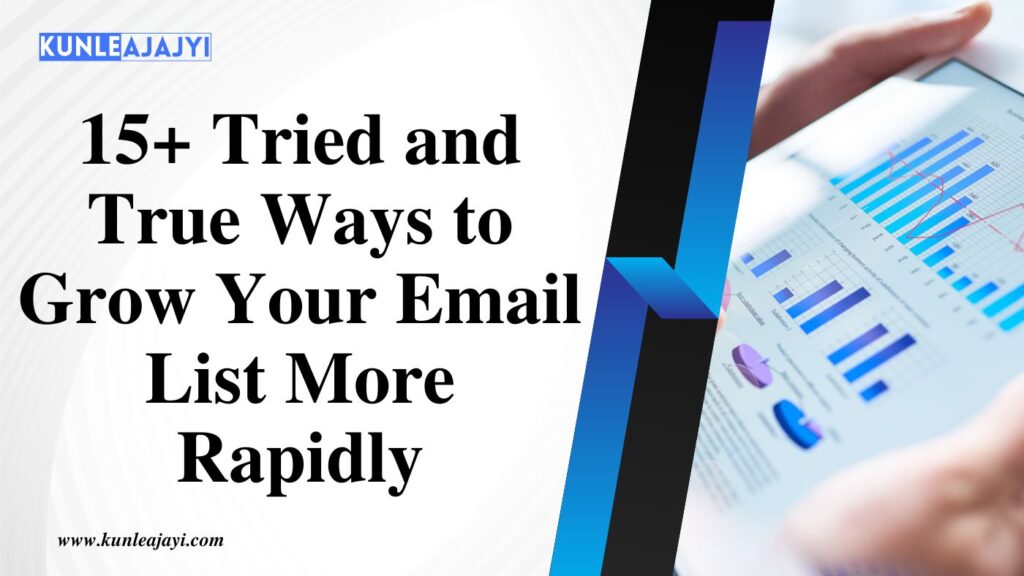One of the most effective strategies to develop a relationship with your customers continues to be email marketing. Your brand may increase revenue and acquire clients’ trust by developing an efficient email marketing plan.
With the capacity to segment your campaigns and test your communications, email is the one marketing channel you have the most influence over. Your business and sales could increase if you implement a solid email marketing plan.
Because email marketing works, more companies are using it. It not only costs less than other types of marketing, but it also converts well, providing you with the best return on your marketing investment. That’s because a lot of the people on your email list are interested in hearing from your business.
In this post, I’ll show you how to create an effective plan step-by-step and provide you with some examples of effective email campaigns.
Ready? Let’s start now!
An email marketing Strategy is what?
A structured technique for contacting new and current clients in order to develop connections and boost revenue is known as email marketing. Target audiences are emailed in a customized manner, and their effectiveness is then evaluated. The finest strategies are developed in accordance with the objectives of the organization and the needs of the target audience.
But for this to succeed, you must write persuasive, valuable marketing emails that encourage readers to act (i.e., make a purchase), whether they be newsletters, email funnels, or other types of marketing emails.
You might even persuade customers to become ardent brand supporters.
Why is an email marketing plan necessary?
Creating revenue is every company’s top priority. To do this, email marketing is a fantastic strategy. It presents your content to those who have already consented to receive communications from your business, accomplishing two goals:
- increases the amount of content that is consumed by your key audience (each email acting as a touchpoint)
- makes it simpler to persuade readers to buy from you
Contrary to its cousin, disruptive advertising, it is non-intrusive. It also has the title of being the most successful marketing channel, according to Litmus. This is perhaps the reason why 37% of businesses increased their email spend in 2022.
Who is to blame for them? With no end in sight, email usage is skyrocketing:
Worldwide e-mail subscribers from 2017 to 2025, according to Statistica [Source]
When done properly, email marketing can have incredible results, such as:
- increases the number of quality visitors that have already expressed interest in your brand as leads
- provide you with direct access to valuable prospects and their money.
- enables you to discover more about your audience through the provision of first-party (and zero-party) data (such as email preferences, email engagement statistics, and purchase history).
- provides a better customer experience by personalizing your emails with behavioral insights.
- Targeting customers who are most likely to convert helps you save money.
- enables you to evaluate email marketing campaigns to see what is effective so you can quickly repeat them to improve results.
- Create the campaign once, and it works even while you’re sleeping, automating the nurturing and sales processes. (Learn more about the kind of emails you can automate here.)
- scales to account for expansion while yet being reasonably priced
You run the danger of shooting arrows in the dark in hopes of hitting something without an email marketing approach. Not necessary. You may always hire email marketing services if you don’t have the time or expertise to develop your approach.
The following issues that brands encounter can be avoided by using an email marketing service:
Data about the problems brands encounter with their email marketing techniques – Source: Ascend
How to Develop a Successful Email Marketing Plan: A Step-by-Step Guide
It’s time to begin developing your plan. What should you put in it to make it work?
Let’s look at it.
1. Determine the goals for your brand.
What objectives are you attempting to fulfill, and why do you believe email will assist you in doing so? The goals you establish should be SMART:
- Specific: Ambiguous goals are challenging to achieve since you can never be sure of when you will arrive. Instead, be specific; for instance, say that by the end of the year, I intend to raise monthly sales by 5%.
- Measurable: It’s simpler to monitor progress when you have a clear goal in mind. For instance, by keeping an eye on the number of new sales each month, I may determine if I are succeeding in my target.
- Achievable: Some companies have lofty goals, and with good reason. Be realistic about what you can accomplish within the time range you set, though, to avoid making this your Achilles’ heel.
- Relevant: Every goal should be in line with the overarching mission of your business. For instance, if your audience doesn’t read thought leadership content and instead uses case studies to inform their purchasing decisions, becoming a thought leader would be pointless.
- Setting a deadline will let you know how long you have to complete your task. Everyone will stay motivated and on task as a result. Additionally, if the time frame is a year, it will prevent you from becoming demoralized if you don’t reach the goal within the first few months.
2. Determine your audience and their problems.
Guessing who your target is and why they might buy your good or service is insufficient. There are really too many resources available to provide data to support your hypotheses.
Knowing and comprehending your top clients is essential to your continuing growth, whether you are releasing your first product or have been in business for years.
But where do you discover them, and how do you enter their minds once you do?
The first step, then, is to examine the data in your Google Analytics account or, if you already have CRM software, your existing CRM database. Use this to determine the traits of your top clients.
For instance:
- What group do they belong to?
- What part of the world are they in?
- What is their spending?
- How long have they been customers and how frequently do they return?
- What is the total cost of ownership?
- How do people discover your name and your goods?
- Which TV stations do they favor?
- What goods do they swarm to?
Now that you know what they’re doing, you need to figure out why.
Interviewing or surveying your top clients is the best course of action. You might wish to inquire about:
- What about my product or service do you enjoy best?
- What do you believe distinguishes us from other businesses in my sector?
- What do you believe I could do better?
- Have you got any recommendations for fresh features or goods?
- How would you rate my customer service?
- How have my goods and services aided you in achieving your objectives?
- How did you discover us at first?
- What could I do to improve your experience that would be the most crucial?
- Would you like to see us provide any other goods or services in the future?
- How do you feel about my price structure?
However, in the event that this isn’t feasible, you can turn to technologies like Sparktoro (or utilize it in conjunction with your surveys and interviews). This analytics tool examines consumer online behavior, including:
- (Keyword research) Typical words used in their bios and social media posts
- Who they interact with and follow on social media (possible influencers to contact)
- Which periodicals and websites do they browse (possible guest posting destinations for backlinks)
- They interact with rivals that you may not have thought of (to assess their advantages and disadvantages)
Additionally, I advise using tools like ChatGPT to find any frequent problems your audience may be experiencing.
After gathering as much information as you can about your most valuable clients, utilize it to guide the kind of content you produce, the platforms where you advertise your material, and the promotions you should provide.
3. Create your content strategy.
Creating your content plan will be really easy because of the data you discovered in the previous phase. You have learned about their interests, pain points, and even their language. You can sprinkle digital gold throughout your content to pique your audience’s interest in the manner they express their difficulties or the advantages of your product.
They’ll think you understand them, which will greatly increase the likelihood that prospects will convert.
What, however, is necessary for an email content plan? Here are some things to think about:
- The number of emails you’ll send each month and the duration of each campaign
- Emails you’ll send will depend on their purpose (transactional, welcome series, onboarding, newsletters, promotions, etc.).
- Each campaign’s themes
- themes and topics for each mailing and campaign
- Whether you’ll publish a brief or lengthy email (and any additional materials it will link to, like downloadable files, blog articles, or videos)
- How frequently you’ll advertise a product (for instance, once each email or every few emails)
- The tone of your writing (for example, casual, amusing, formal, or professional)
With all of this in mind, you might discover the necessity to develop different game plans as part of your overall email marketing strategy, such as a newsletter marketing strategy or a marketing automation strategy.
Here are some examples of the various kinds of content that businesses provide for their email campaigns:
Litmus Source’s 2021 State of Email Marketing Report
To observe what other brands are doing and to obtain ideas for your campaigns, it’s also a good idea to examine instances of their newsletter campaigns.
A content writer (in-house, from an agency, or freelance) can assist you flesh out your content strategy once you have one.
4. Select a platform for email marketing.
It’s time to choose the emailing program you’ll employ to carry out your email marketing efforts. Although there are numerous email service providers (ESPs) available, these are some of the most well-liked ones and why:
- With MailerLite, you can easily design eye-catching newsletters for your campaign using a drag-and-drop editor. To make your email marketing operations more efficient, it also has targeting and automation options.
- ActiveCampaign: If you’re willing to put in the effort to understand it, ActiveCampaign, which is a little more technical than the other options on the list, offers fantastic features. It offers capabilities including contact management, complex sales and marketing automation tools, geo-targeting, website visitor tracking, and scripted responses.
- Brevo: Brevo has all the bells and whistles, including automation, straightforward email design, and a CRM, required to operate a successful email marketing campaign. Additionally, it takes a step further with other marketing methods like chat and SMS marketing.
- GetResponse: A/B testing, analytics, ROI tracking, landing page design, and conversion funnels are just a few of the helpful services provided by GetResponse. Additionally, it enables you to start a retargeting campaign using the Facebook Pixel and monitors website visitors so you can learn more about your target market.
- Mailchimp: Mailchimp is a well-known email marketing platform that includes many of the capabilities you require, such as segmentation, scheduling, and landing pages. Additionally, it offers non-technical business owners a free website builder. (I advise trying the Mailchimp options before deciding.)
- ConvertKit: ConvertKit is a preferred option for content producers like podcasters and bloggers. It can be used to create an automatic email funnel for your affiliate products, e-commerce store, or any things you market.
Once you’ve selected the email marketing platform that best suits your company, it’s time to begin monitoring the performance of your campaigns.
5. Make a template for an email
There’s no need to start from scratch with each email’s HTML coding. By taking the guesswork out of the process, a newsletter template expedites and simplifies it. There are many email template builders available.
Your email template is more than simply the layout, including the placement of graphics, fonts, and color schemes. It also pertains to the format of your emails.
For instance, your email might start with a succinct introduction, followed by a real-life story that highlights a problem, advice on how to solve it, and a call to action.
You might also concentrate on how you show your products, client endorsements, and video demonstrations if you’re working on anything more promotional for an e-commerce firm.
A makeup company might use endorsements, images, and freebies to persuade customers to buy:
Others might launch right into the product pitch, like in the following instance:
This is best for usage with returning clients that don’t need convincing to buy from them (apart from a coupon) and may need to re-up.
Testing your campaigns and being ready to make adjustments until you uncover what works are important because you might not get it perfect the first time. All you need to do is fill in the blanks once you have your go-to template.
6. Create persuading email content
Your email recipients should be eager to read your messages. Although it’s easier said than done, it’s not impossible.
A strong subject line is the key to everything. If you get this correctly, more subscribers will open your emails. You should monitor your email open rate to determine whether the content and subject lines you use are relevant to your audience.
Test your subject lines to make sure they display properly on various devices. You can do this by using my free subject line previewer.
Next, your email content needs to live up to the promise made in the subject line. Make sure you deliver on your promises of an answer, a great bargain, or something of worth.
Opening your emails will be simple if they are valuable. However, convincing people to take the next step calls for the skills of a copywriter who excels at creating compelling content.
Unfortunately, 63% of organizations using email marketing rank improving interaction as their top challenge. This can be avoided by:
- Utilize segmentation, tagging, and dynamic content to further personalize your emails by including the recipient’s name in the subject line and email body.
- Writing compelling copy: Make sure your material has an obvious call-to-action (CTA) and is both fascinating and engaging.
- Design simplification: Use a clean layout with lots of white space and easy-to-read typefaces to keep your emails straightforward.
- Make sure your emails appear fantastic on desktop computers and mobile devices by optimizing them for mobile viewing.
- Research the most likely times that your consumers will open emails, then send your newsletters and emails at those times to increase engagement rates.
- To determine which email subject lines and body copy have the highest engagement rates, do A/B testing. Then, make the necessary adjustments. (See my tutorial for more on how to use email A/B testing in your campaigns.)
- Analyzing performance data: Keep an eye on metrics like open rate, click-through rate, email deliverability rate, conversion rate, bounce rate, and unsubscribes to see how well each campaign performed in terms of achieving its targets.
My comprehensive guide has further information on writing marketing emails.
7. Continually evaluate and restate your email marketing strategy
If you don’t monitor what’s happening on a monthly basis, your approach is doomed from the start. You can determine if you’re on the right track or if you need to make changes by keeping an eye on the metrics that are most important to your campaign.
Depending on your campaign goals will determine which metrics you should track. For instance, you should concentrate on the average conversion rate of form fills coming from your email campaigns if you want to boost the number of website form submissions.
The most popular email marketing KPIs (key performance indicators) that companies monitor in their campaigns are listed below:
- Measures the number of recipients who have opened your email.
- Measures how many recipients of your email clicked on a link, or click-through rate (CTR).
- Measures how many emails you sent bounced back to you because of an incorrect address or another delivery problem.
- Measures the number of individuals who unsubscribe from your list after receiving your email.
- Measures how many recipients of your email really did what you asked them to do, like as fill out a form or make a purchase.
You may learn what works and what doesn’t for your audience by tracking these stats over time and modifying your email approach accordingly.
This is simpler to accomplish if you have data visualizations that are simple to read and that were created utilizing email marketing tools (like those I described above).
Every successful email campaign starts with a plan.
When starting your first email marketing campaign, there are many things to learn, but it’s not tough. Testing must be done often to determine what is effective. You’ll have a bird’s eye perspective of what’s working and what isn’t with your analytics tools at your side, providing you the assurance to make wise campaign-related decisions.
You’ll be well on your way to developing an effective email marketing strategy if you combine this with the previous steps.
Both large corporations and small businesses can benefit from email marketing. Half the battle is already won if you can persuade folks to join your email list. Just be sure to stay away from these typical email marketing errors.
Starting now is the only thing left to do!




